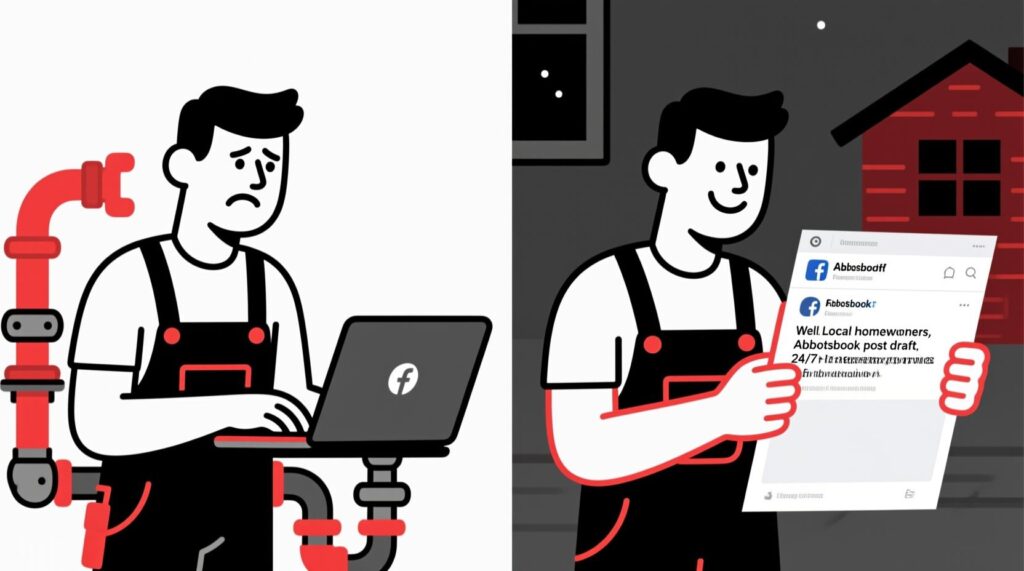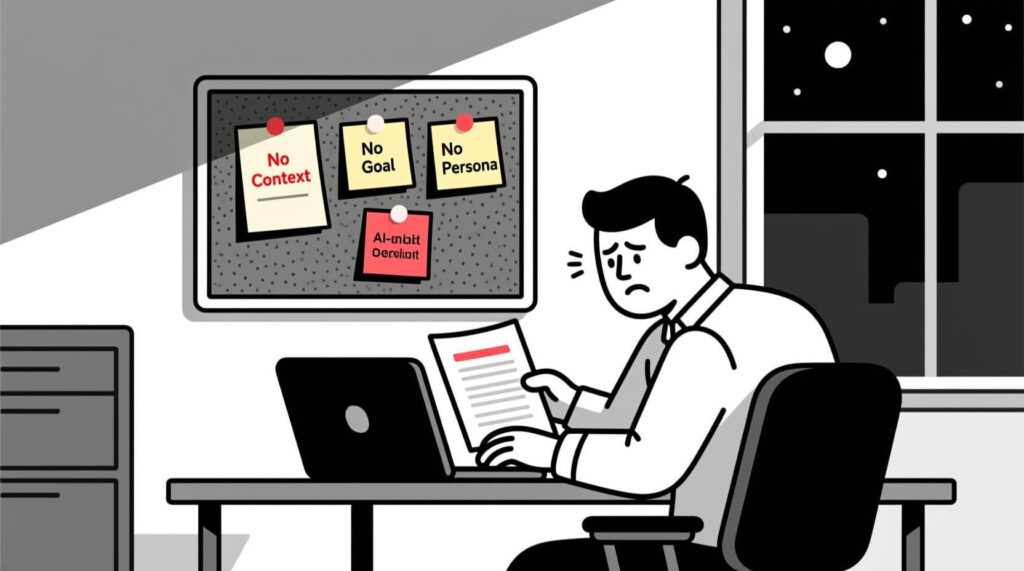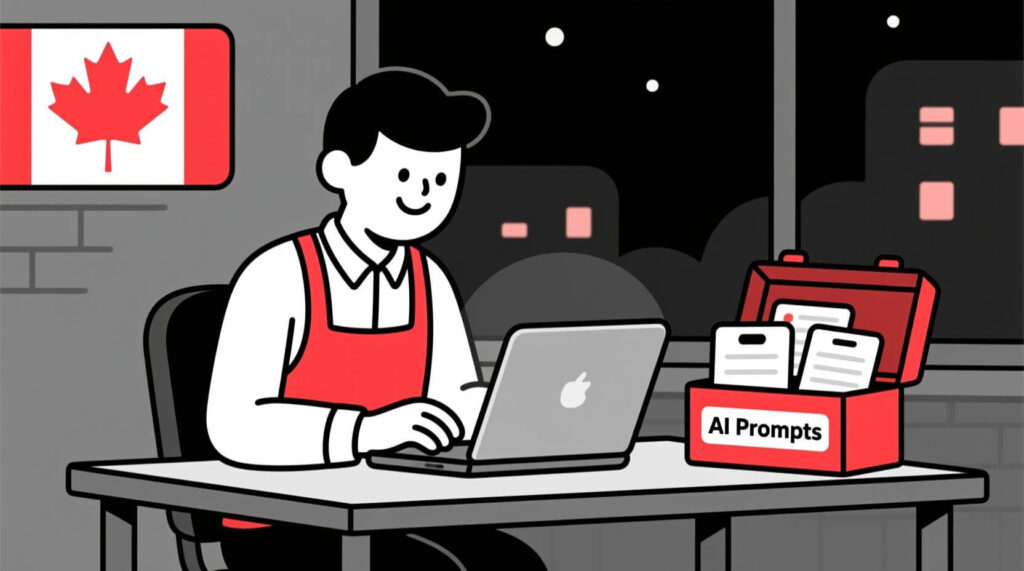
It’s 9 PM on a Tuesday. You’ve finally got the kids to bed, cleared the dinner table, and now you’re staring at the blinking cursor, a dozen business tasks swirling in your head. You need a social media post for this week’s sale, but your brain is fried.
Someone told you AI could help. So you open up ChatGPT and type:
“Write a social media post about my business.”
What you get back is… an insult. It’s a paragraph of words so generic, so bland, so utterly devoid of personality that you’d be embarrassed to put your company’s name on it. It’s useless. So you close the tab, feeling like you’ve just wasted 15 precious minutes and thinking, “Well, I guess this AI thing is just a bunch of hype for tech guys in Toronto.”
Sound familiar? You’re not alone. The truth is, a surprising number of Canadian business owners are in the same boat. While one study found that 66% of Canadian SMEs are using AI tools, many are “unintentional” users. They’re dabbling, but not using it strategically.
This leads to what some call the “imagination gap”—the reason a staggering 78.1% of businesses not planning to adopt AI believe it isn’t relevant to their operations. They tried it, got garbage results, and wrote it off.
But here’s the secret: the problem isn’t the AI. The problem is how we’re talking to it. The quality of an AI’s output is a direct reflection of the quality of your input. It all comes down to one golden rule: Garbage In, Garbage Out.
The Real Reason AI Is Letting You Down (Hint: It’s Not the AI)

Think of ChatGPT or any other AI tool as a brand-new employee on their first day.
This new hire is incredibly smart, infinitely fast, and genuinely eager to please. They’ve read basically the entire internet and can write, code, and brainstorm faster than anyone you’ve ever met. But they have one huge flaw: they know absolutely nothing about you.
They don’t know you’re a plumber in Abbotsford. They don’t know your brand voice is “friendly and trustworthy.” They have no idea your target customer is a homeowner who values reliability over a cheap price.
When you give that brilliant-but-clueless new hire a vague command, they can only give you the most average, generic answer possible because they have zero context. The AI isn’t being lazy; it’s doing its best with the nothing you’ve given it.
“Garbage In, Garbage Out”: The Golden Rule of AI Prompts

This is the most important concept in all of AI writing. A prompt is simply the instruction you give to an AI. And the difference between a bad one and a good one is the difference between getting useless fluff and getting a brilliant first draft that saves you hours.
Think of it like a recipe. You can’t just tell a baker “bake a cake” and expect to get your grandma’s secret chocolate fudge recipe. You have to provide the ingredients, the measurements, the temperature, and the steps. A prompt is the recipe for the result you want.
Let’s look at a real-world example.
What most people type (Garbage In):
“Write a Facebook post about my plumbing services.”What you should be typing (Quality In):
“Act as a friendly, expert plumber in Abbotsford, BC. Write a short, helpful Facebook post for local homeowners. The goal is to build trust and show we're reliable. Mention our 24/7 emergency service for winter problems like burst pipes and clogged drains. End with a question to encourage comments and a link to our website.”See the difference? The second prompt isn’t more “technical.” It’s just better instructions. It gives our “new hire” the recipe it needs to do a great job. It transforms the AI from a vague idea generator into a genuinely helpful marketing assistant.
Canadian AI Guy’s Pro Tip: Here’s a quick win you can implement in the next 5 minutes. Open up a notes app and create a new note called “My AI Context.” In it, write 3-4 bullet points that describe your business basics: who you are, what you sell, who your ideal customer is, and your location. The next time you use an AI, just copy and paste that context at the beginning of your prompt. It’s a tiny step that makes a huge difference.
Three Mistakes Nearly Every Canadian Business Makes with AI

If your results have been disappointing, chances are you’re making one of these three common mistakes.
Mistake #1: Providing Zero Context.
You’d never ask a new marketing assistant to “make an ad” without telling them who it’s for. The AI is no different. You have to tell it about your audience, your location, your unique selling points, and what makes your business special.
Mistake #2: Having No Clear Goal.
What is the purpose of the content? Are you trying to get clicks on your website? Educate potential customers about a problem? Announce a sale? A prompt without a clear goal is like a car without a steering wheel—it might move, but it’s not going anywhere useful.
Mistake #3: Forgetting the Persona.
Who do you want the AI to be? A witty social media manager? A formal business consultant writing a report? A helpful customer service agent? Assigning a role or a “persona” is the single fastest way to change the tone, style, and quality of the output.
Canadian AI Guy’s Pro Tip: It’s a lot to remember when you’re already juggling a dozen other things. If you want to skip the trial-and-error and get your team saving time with AI right away, this is exactly what we cover in our hands-on AI Training Programs. We can build a custom workshop or DFY AI GPTs/GEMs for your organization and get you past the “garbage out” phase for good.
The Simple Fix: Start Thinking “Instructions,” Not “Questions”

Here’s the mindset shift that changes everything: Stop treating AI like a simple search engine and start treating it like a capable team member.
You’re not just asking it a question. You are delegating a task.
I know what you might be thinking: “This sounds like it’s going to take more time to write a long prompt than to just write the darn thing myself.” In the beginning, it might feel that way. But it’s an investment of two minutes up front to save thirty minutes of frustrating edits and rewrites on the back end. A good prompt is like a mini project brief. It has a goal, an audience, key details, and a desired tone of voice.
Your 3-Minute Fix: How to Immediately Improve Your Next Prompt

Before we even get to the full framework in our next article, you can dramatically improve your results by adding just three things to your next prompt. Think of it as the bare minimum recipe for success.
- Assign a Role: Start your prompt with the phrase “Act as a…” (e.g., Act as a witty social media manager… Act as an expert financial advisor…)
- State the Goal: Clearly define the purpose by adding “The goal is to…” (e.g., …the goal is to get clicks on this blog post… …the goal is to build trust with new clients…)
- Define the Audience: Specify who the content is for by stating “This is for…” (e.g., …this is for tech-savvy entrepreneurs in their 30s… …this is for homeowners in rural Alberta…)
Just by adding those three simple elements, you give the AI the critical context it needs to move from “garbage” to “good enough for a first draft.”
The good news is, this is a learnable skill. Now that you know why your prompts have been failing, you’re ready to learn the solution. In the next article in this series, we’ll give you the complete 5-Step Framework for Writing Perfect Prompts Every Single Time.
Conclusion: You’re the Boss, Not the Bot

For a while there, it might have felt like the AI was the problem. But the power has been in your hands all along. Artificial intelligence is an incredibly powerful tool, but it’s just that—a tool. The quality of the results is always determined by the skill of the person using it.
And the best news? You already have the core skill you need. You know how to give good, clear instructions to people. Now you just need to apply that same logic to the bot.
But if you’ve read this far and are thinking, “This makes sense, but I just don’t have the time to figure it all out,” don’t worry. We’ve got your back. Whether you need a hands-on training session for your team or a ‘done-for-you’ solution to a specific marketing problem, reach out and let’s have a chat. Sometimes the fastest way to get ahead is to just ask for a little help, eh?
Ready to learn the framework? Keep an eye out for Part 2 of the AI Prompting Playbook, coming next week.
Frequently Asked Questions (FAQ)
1. Why does ChatGPT give me such generic answers?
ChatGPT gives generic answers when it receives generic prompts. Without specific context about your business, your audience, and your goal, it defaults to the most common, middle-of-the-road information it was trained on, which often sounds bland and impersonal.
2. How do I get more specific results from an AI?
To get more specific results, you need to provide more specific instructions. Include details like:
- Persona: “Act as a…” (e.g., expert marketer, friendly plumber).
- Audience: “Write this for…” (e.g., busy homeowners, tech-savvy entrepreneurs).
- Goal: “The purpose of this is to…” (e.g., drive traffic to my website, build trust).
- Context: Include key details about your product, service, or location.
3. What is the “garbage in, garbage out” rule for AI?
This is the golden rule of AI. It means the quality of the output you receive from an AI is directly determined by the quality of the input (the prompt) you provide. Vague, low-effort prompts will produce vague, low-quality results. Detailed, thoughtful prompts will produce detailed, high-quality results.
4. Do I need to be a programmer to write good AI prompts?
Absolutely not. Writing a good prompt has nothing to do with coding. It’s a communication skill. If you can write a clear email or give good instructions to a new employee, you have the foundational skills to write effective AI prompts.
5. How can I make AI sound like my business’s brand voice?
The best way is to provide examples! You can include a short paragraph of your existing writing in your prompt and say, “Please write the response in a similar tone and style to this example.” You can also describe your brand voice in the prompt (e.g., “Use a friendly, witty, and slightly informal tone”).


